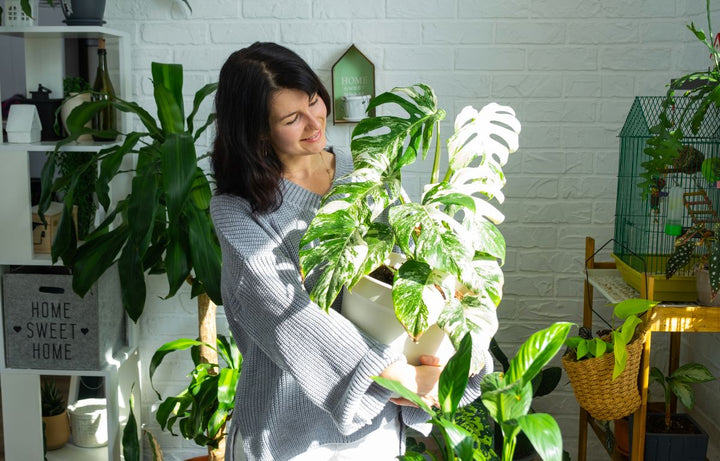
20 Things You May Not Know About Your Indoor Plants: Part 2
20 Things You May Not Know About Your Indoor Plants: Part 2

1. The spikes on cactus plants are not thorns but are in fact leaves. The leaves are spiked to protect the plant from predators and are also used to collect rainwater and shade the plant reducing moisture evaporation during the day.
2. Variegated houseplants grow slower than fully green ones because their leaves contain less chlorophyll, reducing their ability to photosynthesise efficiently, and limiting their energy production and overall growth rate.
3. Plants can sense gravity through specialised cells called statocytes. These cells contain starch-filled organelles, which settle according to gravity, guiding the plant to grow roots downward and shoots upward.
4. Devil's Ivy Pothos, Spider Plants Chlorophytum comosum, and Snake Plants Sansevieria are some of the easiest houseplants to propagate. Simply place Devil's Ivy cuttings in water, plant Spider Plant offshoots, and divide Snake Plant rhizomes for new growth.
5. Some of the fastest-growing houseplants include Devils Ivy Pothos, Philodendron Xanadu, Begonia varieties, and Boston Fern. They can quickly double in size within a few months if well cared for.
6. Although many houseplants are known to originate from Central America, Africa and Asia, some of our favourite houseplants such as the Umbrella Tree Schefflera actinophylla, Kentia Palm Howea forsteriana, and Hoya Australis are Australian natives.
7. The ZZ Plant Zamioculcas zamiifolia, Jade Plant Crassula ovata, Snake Plant Sansevieria trifasciata, and Hoyas are Succulents. These plants have adapted to store water in their leaves and stems, making them drought-tolerant, low-maintenance, and able to thrive in various indoor environments.
8. The Swiss Cheese plant or Monstera deliciosa also known as Mexican Breadfruit or Fruit Salad Plant. When grown wild in its native regions of Mexico and Central America, this plant produces an edible fruit that supposedly, tastes like a cross between pineapple, coconut, banana and even strawberry. However, it has a short ripe period. Unripe fruit can cause skin and mouth irritation when ingested.

9. When planted together, some houseplants can recognise their siblings (other plants that come from the same parent plant). They will share resources, and even entwine their roots and stems as they grow. In contrast, when planted with strangers, the same plants compete for nutrients and water and will separate themselves as much as possible.
10. Spreading used coffee grounds around the topsoil of your potted plant can deter pests like ants, slugs, and snails from eating the delicate foliage and newly formed stems.
11. The roots of plants are covered in fine protrusions called Root Hairs. The Root Hairs are designed to create a larger surface area for more absorption of water and nutrients from the soil. They also help anchor and stabilize the plant in place.
12. The Monstera family produces some of the rarest and most sought-after plants for houseplant collectors. These include the Monstera deliciosa variegated Thai Constellation, Monstera Obliqua Peruvian Form, and Monstera deliciosa Borsigiana Albo vareigata. Mature plants have been known to sell for hundreds of dollars.
13. The Snake Plant Sansevieria trifasciata, Spider Plant Chlorophytum comosum, and Devil's Ivy Pothos make excellent additions to the bedroom. This is due to a process called Crassulacean Acid Metabolism (CAM) in which their stomata open at night rather than during the day to reduce water loss. During the day, when the stomata are closed, the stored carbon dioxide is used for photosynthesis, which produces oxygen even without sunlight.
14. The name for Dracaena plants, comes from an ancient Greek word Drakaina meaning ‘female dragon’. It was thought the red sap produced from its woody stems looked like dragon blood, hence the name.
15. When cared for and well maintained, houseplants like the Snake Plant Sansevieria trifasciata, Hoyas, and Aglaonemas will have an average lifespan of about 10 years. Monstera and Philodendron plants can live anywhere from 5-50 years. Succulents like the Jade Plant can live up to 70 years, and cactuses like the Saguaro can live anywhere from 150-175 years of age.
16. The Pineapple originates from South America and is a member of the Bromeliad family. New pineapples can be propagated from the tops of healthy store-bought ones and grown as more unusual-looking houseplants.

17. Houseplants became popular in England and Europe during the 1800’s. Predominantly showcased in the homes of wealthy and upper-class Victorians, plants such as the Parlour Palm, Cast Iron Plant, and Ferns were favoured for their ability to thrive in low-light environments.
18. When found in their native habitats, most Philodendron plants are epiphytes or semi-epiphytes, meaning they grow from or live on the surface of another plant. The more commonly known plants that do this are Staghorn Ferns, Bromeliads, and many varieties of Moss and Orchids.
19. Unfortunately, the name Philodendron Xanadu was not inspired by Olivia Newton-John’s 1980 movie. Instead, it is believed to be named after the mythical city of Xanadu from Samuel Taylor Coleridge's poem "Kubla Khan”.
20. The Indonesian Corpse Flower Amorphophallus Titanium is one of the rarest plants in the world. Not only is this family member of the Araceae unique in that it is noticeably warm to the touch, but the biological process results in a pungent rotting flesh smell designed to attract more pollinators.
